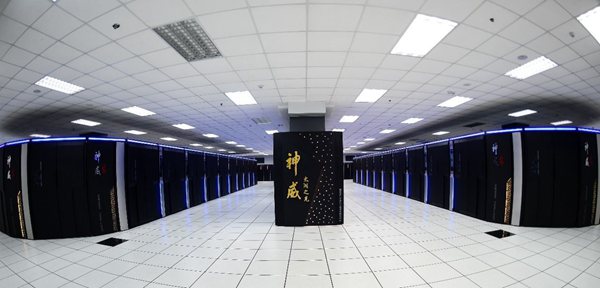


China had missed great opportunities during technological revolutions in the past centuries and it finally started to catch up with the world, said Silicon Valley-based investor and best-selling author Wu Jun at an interview.
One notable reason behind the progress was the diverse areas that Chinese entrepreneurship and scientific innovation are able to take place in. The scenario and technology have been the two gears that pushed history forward.
The US has been using technology to drive business situations, while China’s progress in technology has been pushed by new situations. For example, search technique led to the legend of Google, whereas in China, the e-commerce platform and payment system of Alibaba resulted in cloud computing, mobile payment, biometric identification, which turns out to be the synonyms of “China Wave”.
China’s progress is recognized by the world without doubt.
First of all, talent aggregation. A great amount of talents with skills in technology are coming back to China in recent years. In 2014, the number of Chinese students coming back from foreign countries surpassed students going abroad for education for the first time. In 2015, the number of students returning home is 77% of the total amount of students studying abroad. The percentage is only 23% 15 years ago.
Among the list of Innovators under age 35 by MIT Technology Review in 2017, six of them are Chinese. American author and public speaker John Naisbitt once said that more star entrepreneurs emerged in China, as it did in America during information revolution, and made the world aware of Chinese brands.

Second, progress in technology. The traffic of Chinese high-speed railway within five years outweighed France, that has 34 years’ history in operating railways. Its construction cost is only 1/3 to 1/2 of the cost of railway in German and France. China’s Tiangong will become the only operating space station in the foreseeable future.
China’s Sunway TaihuLight ranked top among 500 leading supercomputers worldwide. Its research and application in artificial intelligence has earned an authoritative place globally. As for financial technology, China’s mobile payment scale is 50 times as large as the amount of America.
Third, Chinese people’s convenient life amazes the whole world. Five years ago, we could hardly imagine our life would be like this:
It takes merely 5 hours to travel from Beijing to Shanghai, 1/4 of the travel time in the past; few people queue up any more. Everything can be done using a mobile phone; wallet is not necessary. In the era of facial recognition, you can simply “smile to pay” even without bringing a mobile phone.
Fourth, the power of China’s exports is worthy of noticing. Every wave is a revolution from technology to business models, and to lifestyles. Currently, China has become the learning object of many countries.
In India, QR codes are used in many restaurants, gas stations, bakery stalls, and teahouses. In Indonesia, people use mobile phones not only to arrange transportation services, but also to order food, package delivery, and dry cleaning services. Vietnam, Laos, Myanmar, Thailand, Malaysia, Singapore, Russia all intend to import China’s high-speed train technology. Traveling around the world on China’s high-speed rail is not a dream any more. We also see the Thai version of Headlines Today, the Malaysian version of Taobao, and the Singaporean version of Xian Yu, a second-hand online marketplace developed by China’s Alibaba Group. All of these mentioned above make Chinese tourists feel at home.
On a bigger scale, the mobile lifestyle of Chinese people is influencing the whole world. One can use Alipay to shop from Printemps in Paris, the UK’s Harrods, Finnair,Norwegian Cruise Line, City Sightseeing South Africa, or even within the Arctic Circle. “Hi, thank you, and Alipay” are the three things each foreigner has to learn. Bike-share services provided by Chinese companies are also available in more than 100 cities worldwide including Berlin and London.
The impact of “China Wave” is so huge that The Economists comments, “Western consumers are having their experience of the mobile internet shaped by a Chinese success story. Companies that want a glimpse of the future of mobile commerce should look not just to Silicon Valley but also to the other side of the Pacific.”
 Fire brigade in Shanghai holds group wedding
Fire brigade in Shanghai holds group wedding Tourists enjoy ice sculptures in Datan Town, north China
Tourists enjoy ice sculptures in Datan Town, north China Sunset scenery of Dayan Pagoda in Xi'an
Sunset scenery of Dayan Pagoda in Xi'an Tourists have fun at scenic spot in Nanlong Town, NW China
Tourists have fun at scenic spot in Nanlong Town, NW China Harbin attracts tourists by making best use of ice in winter
Harbin attracts tourists by making best use of ice in winter In pics: FIS Alpine Ski Women's World Cup Slalom
In pics: FIS Alpine Ski Women's World Cup Slalom Black-necked cranes rest at reservoir in Lhunzhub County, Lhasa
Black-necked cranes rest at reservoir in Lhunzhub County, Lhasa China's FAST telescope will be available to foreign scientists in April
China's FAST telescope will be available to foreign scientists in April "She power" plays indispensable role in poverty alleviation
"She power" plays indispensable role in poverty alleviation Top 10 world news events of People's Daily in 2020
Top 10 world news events of People's Daily in 2020 Top 10 China news events of People's Daily in 2020
Top 10 China news events of People's Daily in 2020 Top 10 media buzzwords of 2020
Top 10 media buzzwords of 2020 Year-ender:10 major tourism stories of 2020
Year-ender:10 major tourism stories of 2020 No interference in Venezuelan issues
No interference in Venezuelan issues
 Biz prepares for trade spat
Biz prepares for trade spat
 Broadcasting Continent
Broadcasting Continent Australia wins Chinese CEOs as US loses
Australia wins Chinese CEOs as US loses